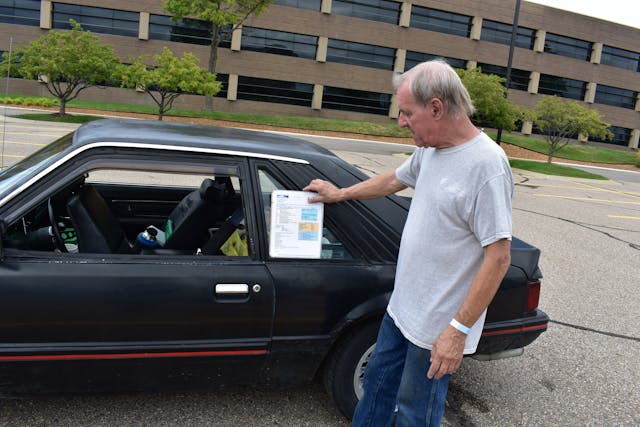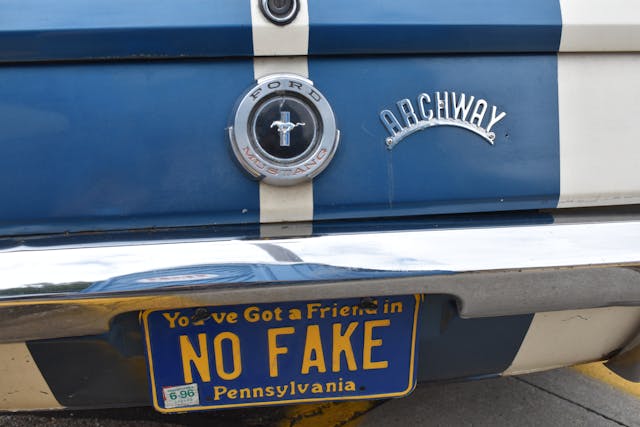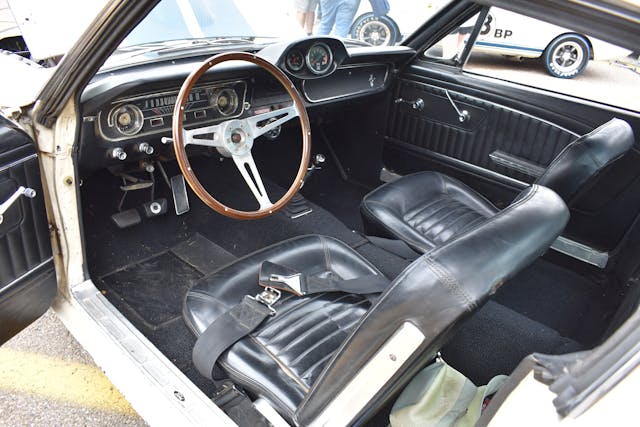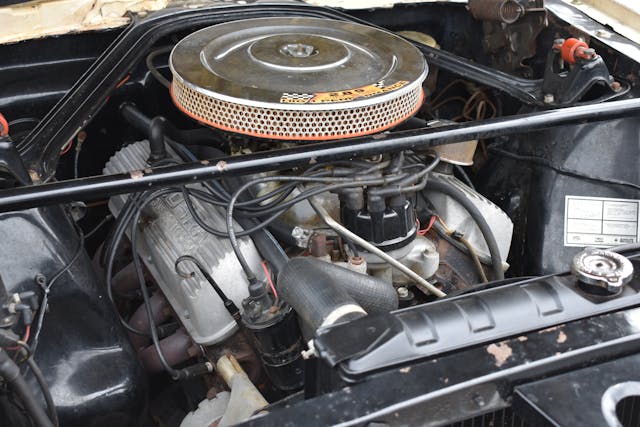Media | Articles
Tale of Two Survivors: The sixth-built Shelby GT350 and a ’79 Mustang Cobra with 350K miles
The Woodward Dream Cruise is officially a one-day event, but it’s also become the anchor event for local, national, and even international car clubs to hold their own meets and shows before and after the Saturday Dream Cruise. For example, this year, the weekend before the Cruise, the American Motors Owners club had its international meet at the historic Greenmeade Farm in the Detroit suburb of Livonia. Also, every year when DeLorean owners gather in Detroit for the WDC, they make a pilgrammage to White Chapel Cemetery to pay their respects to John Z. And on the Sunday following the Dream Cruise, the Mustang Owners Club of Southeastern Michigan (MOCSEM) holds its Mustang Memories show in the shadow of Ford Motor Company headquarters in Dearborn. It’s a judged show with 500 registered cars.
Despite the title, the Mustang Memories show is automotively ecumenical, with Mustang IIs, Fox-body Capris, Cougars, and really any Ford products welcome. There were even a couple of identical Mustang Mach E electric cars, apparently ordered months apart by two different owners, but built sequentially, at least according to the VINs.
Now some cars are so common at car shows as to be cliches. Do I really need to see another ’69 Camaro that isn’t at least a Yenko replica? At a show like Mustang Memories, with so many exciting vehicles, it’s hard to pick out one or two that are genuinely exceptional, but I believe that I stumbled upon a couple of very special cars. They’re both survivors, worthy of note, and while they are both dearly loved by their owners, who have owned them for decades, one of them is as valuable as a house and belongs in a museum, while the other might not get a second glance from even a Mustang fan. I think they’re both cool as can be.
Gary Rusch is the original owner of a 1979 Mustang Cobra, even though the car had about 24,000 miles on it when he bought it from a Ford dealer in 1980. It had a sticker price of $6578, including delivery charges, financed through Ford Credit. Since then he’s put on about another 325,000 miles, and the black car shows every mile, with patches and an irreproducible patina on the sheet metal.
The 1979 model year was the first for the Fox-body Mustang, and Ford carried over the Cobra subbrand to the new model from the Mustang II, available with either the 5.0-liter V-8 or Ford’s then-new turbocharged version of the 2.3-liter “Lima” inline four. While some might disparage the idea of a Cobra-branded Mustang with a four banger, the truth is that the turbo four put out 134 horsepower compared to that malaise era V-8’s 139, and being a lighter car, the four-cylinder Cobra may even have been faster.
Marketplace
Buy and sell classics with confidence
That might have been the case, but the car was literally a hard sell back then, which explains why it gathered all those “demo” miles. I suggested to Rush that some of those demo miles might have included more than a few burnouts by dealership staff, to which he replied, “Oh, yeah!”
As you would expect, with more than a third-of-a-million miles on the odometer, Rush’s Mustang Cobra is hardly original. Mechanical changes include replacing the stock four speed with a five-speed transmission and Hurst shifter, and the cast aluminum wheels are not stock. He said that he has to regularly replace the “flaming chicken”-era Cobra decal on the hood, as it deteriorates in sunlight, and he’s subsituted a magnetic Cobra decal for the original adhesive one. The Mustang’s matte finish is the result of decades of sunlight, not a four-figure custom paint option.
I don’t know how much Rusch’s car is worth. No disrespect to him, but as dear as it is to him it can’t be worth more than a few thousand bucks at this point. At the other end of the spectrum is Bill Collins’ Shelby GT350. While Rusch’s Mustang was at the perimeter of the event, Collins’ Shelby was in a place of honor right next to the Shelby American truck.
Collins bought his car for a mere $1900 in 1971 (a bit more than half of what a new Mach 1 would have cost that year), when it was just another used up race car. It is now valuable enough that Collins has turned down offers of a half-million dollars. What makes it worth that much? It was only the sixth Shelby Mustang that was made in Shelby American’s original shop in Venice, California, before the operation moved to hangers at the Los Angeles airport, and it’s still in mostly original condition. Not only that, but its provenance also includes being also one of the original Shelby show cars.
The sixth Shelby Mustang by serial number (SFM5006) it was one of the first group of “Advanced Prototype” GT350s completed at the Venice facility in January 1965. An internal Shelby American memo dated January 29, 1965 designated SFM5006 as a factory show car after the Mustang was displayed and driven at the first public display of the GT350 at a press preview at the Riverside Raceway on January 27, 1965. The next month it was air shipped to Philadelphia for display at the Philadelphia Auto Show and the SCCA’s national convention, likely making it the first Shelby Mustang to reach the east coast. The principal of Baltimore’s Archway Ford saw the car on display at the Philly auto show and arranged purchase. Archway later displayed the car at the Baltimore World of Wheels auto show in March 1965, where it was purchased by its original registered owner, Gene Collins (no relation to current owner). The original Archway badge is still attached to the rear fascia, above the car’s NO FAKE vanity plates.
Bill Collins bought it in March 1971 and proceeded to street race, drag race, and, as he puts it, “generally raise hell with it for 10 years.” Through all that abuse, SFM5006 managed to keep its original engine and drivetrain intact. For the most part, the GT350 is straight and solid, though the rear bumper is a bit askew. The interior looks fairly good for a car of its age and mileage. Collins put the car into storage in 1980s, but 30 years later he pulled it out so he “could raise hell with it again.” On the information sheet that Bill displays with the GT350, he says, “Restore it? You’ve got to be kidding! It took me 48 50 51 years to get it looking like this!”
As mentioned, the car is mostly original. Collins has replaced the radiator with a thicker, modern one to deal with overheating while cruising and in parade events, and before he bought it had a fender replaced and was repainted. It’s a numbers-matching car, although the engine had also been rebuilt by a previous owner. Of course, like all old race cars, it had modifications done when it was actively racing. You can see where Collins had to do some rebuilding and restoration work on the Shelby’s original fiberglass hood, which a previous owner had changed to secure with four hood pins, and had removed the hinges. The aluminum spoked, wood-rimmed steering wheel has also been restored, though the clearcoat used has appropriately yellowed.
Collins figures that he’s the fifth owner of the car, which now has about 78,000 miles on it. He drives it pretty regularly. A Shelby and Ford performance fan, Collins turned his hobby into a business, Bill Collins Collector Fords, in Harrisburg, Pennsylvania, where he maintains an inventory of about 35 cars for sale, along with parts and literature. The GT350, though, is his personal car, and it’s a one-car collection. Of course, if you are a Mustang or Shelby fan, would you really need another car?
When I asked him if he ever regretted turning his hobby into a job, he said that Mustang owners are a community, and dealing with them keeps the hobbyist feel.
Speaking of feelings, I’d say that Collins and Rusch hold the same level of affection for their cars, regardless of their dollar values.
Check out the Hagerty Media homepage so you don’t miss a single story, or better yet, bookmark it.




























Great topic and a very well presented article. Real cars and real stories are so refreshing to see these days when so much fraud and fakery takes place nearly everywhere we go.